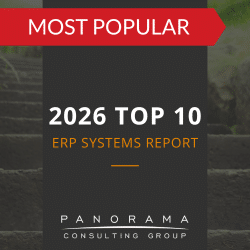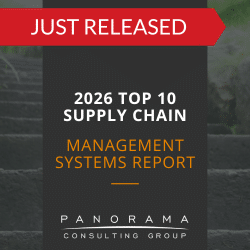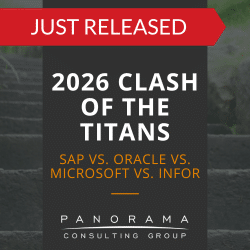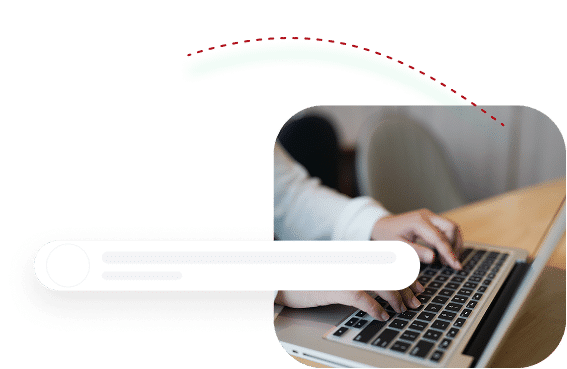Organizational change management (OCM) is a necessary component of enterprise software implementations. It involves making sure that all your employees have the knowledge they need to use the new platform confidently and effectively.
Change management is a continuous effort that doesn’t stop as soon as the system is up and running. In fact, reinforcing change is key at every project touchpoint, including after go-live.
Today, we’re sharing how to use positive, consistent reinforcement to ensure a successful ERP implementation, one interaction at a time.
ERP Training Plan Success Story
We helped this manufacturer implement an ERP training strategy to increase user adoption of its new ERP system.
What is Change Reinforcement?
When you implement new software across your organization, the process can take months or even years to complete.
Change management is about keeping your employees in the loop prior to ERP selection and throughout the long implementation process. They need to know what’s happening, why it’s happening, and how it will affect their roles.
While the actual go-live might happen over a short period of time, reinforcement is a much more extended effort. It involves three main components:
- Collecting and analyzing employee feedback
- Identifying gaps and managing change resistance
- Implementing corrective measures and recognizing success
Let’s look at each component in more detail:
1. Analyzing Employee Feedback
There are a few ways that business leaders can gather the type of employee feedback they need to reinforce positive change. Here are the most common strategies:
Listen to Employees
It might sound simple but listening can be highly effective.
Once certain changes are in place, we recommend following up with end-users to understand how the changes are working. To ensure these meetings are productive, ask direct, targeted questions that will get employees talking.
Without this step, it’s easy to check all the boxes on your change checklist and assume your work is done. Unless you actually sit down and have a conversation with the people using the ERP system, you might miss critical concerns.
With the insights you glean, you can initiate post-implementation change management strategies.
Audit Employee Compliance
If you’re implementing enterprise software, you want to make sure your teams are using it to its full capacity. Auditing employee compliance identifies employees who are reverting to their old workflows because they don’t feel competent (or they dislike) using the new ERP software.
It’s important to reach a consensus on how you’ll measure compliance and who is responsible for each task. A few of the different approaches include:
- Observing employees
- Measuring system usage
- Running performance reports
- Identifying the use of former workflows
Analyze OCM Effectiveness
Feedback doesn’t just apply to employees. It’s equally important to measure your own progress and make sure your project team is doing everything in its power to support successful change.
Metrics you can analyze to track these efforts include:
- User adoption metrics
- Overall employee performance
- Overall project performance
- Organizational readiness
- Results from qualitative or feedback
2. Identifying Gaps and Managing Resistance
If feedback or compliance audits reveal performance gaps in your change management strategy, then it’s critical to address them before they snowball into bigger issues. There are three ways you can do so:
Determine the Root Causes
Often, employee feedback data will be enough to tell you exactly where the problem lies. If it isn’t immediately clear, then continue to dig until you know where to focus your efforts.
A root cause analysis can help you uncover even more information on each problem area.
Plan Corrective Actions
Once you know what’s behind the performance gaps, you can determine strategies to combat these issues.
Do you need to change your communication strategy? Should you redesign your training programs to be more comprehensive?
By tailoring your approach to the specific issues impeding change, you can become quite effective at reinforcing change.
Assign and Enable Change Sponsors
Managing resistance and implementing corrective actions isn’t a job for one or two people. Rather, you’ll need the support of project managers and supervisors who can act as change sponsors and advocates.
3. Implementing Corrective Measures
Next, your supervisors and primary change sponsor will implement the corrective actions identified in Step 2.
During this time, they should celebrate successes by recognizing when employees reach major milestones. Following are several ways to celebrate success:
- Organizing group achievement recognition
- Recognizing achievements during meetings
- Empowering supervisors with resources to recognize employees
Reinforcing Change One Step at a Time
By taking a long-term approach to change management, you can ensure that change sticks. Assuming it’s a one-and-done effort can be a recipe for ERP failure.
This three-step approach to reinforcing change can lay the groundwork for continued ERP success, which ultimately boosts your ROI and your bottom line.
Our ERP consulting team can guide you through every phase of your OCM journey. Contact us below for a free consultation.













